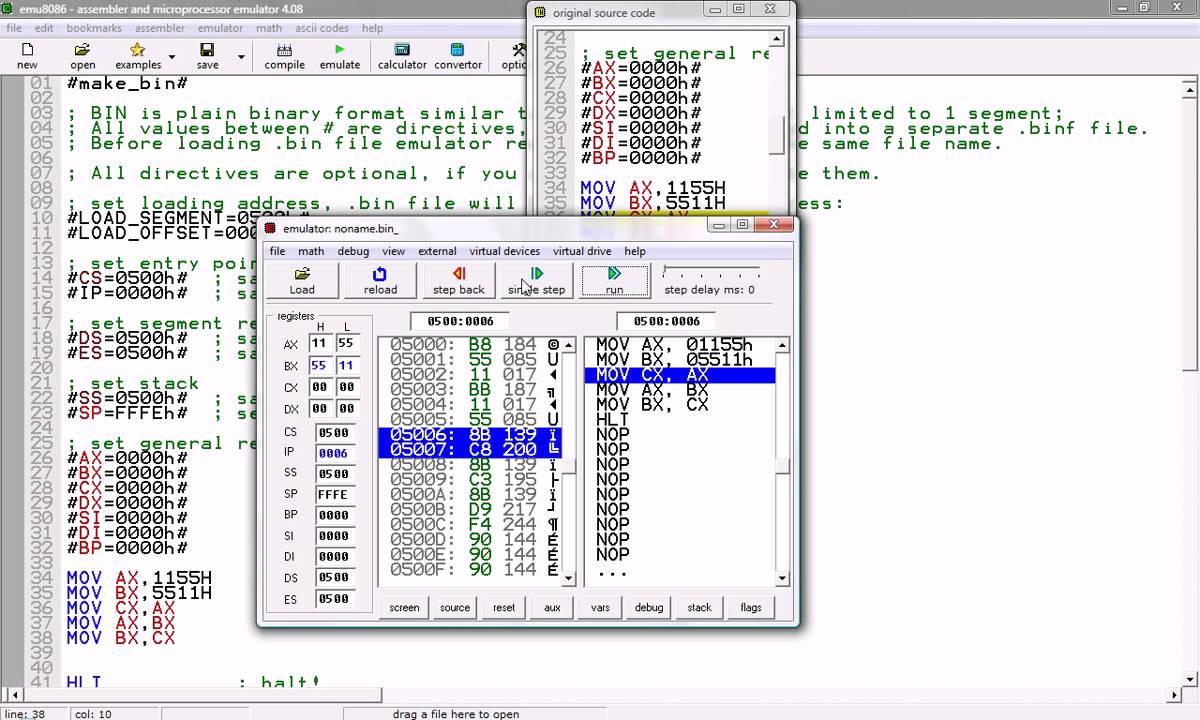Online Asm Compiler, Online Asm Editor, Online Asm IDE, Asm Coding Online, Practice Asm Online, Execute Asm Online, Compile Asm Online, Run Asm Online, Online Asm Interpreter, Compile and Execute Assembly Online (Nasm v2.13.01). A SIMULATOR FOR THE INTEL 8086 MICROPROCESSOR. Chapman A Thesis Submitted in Partial Fulfillment of the Requirements for the Degree of Master of Science.
- Online Emulator 8086
- Online Simulator 8085
- Emulator 8086 Online
- Emulator 8086 Online Compiler
- Online 8086 Emulator For Mac
Online Emulator 8086
 always takes an offset (there is no special mode for a 0 index).
always takes an offset (there is no special mode for a 0 index).Then you get to the segment registers. As if things weren't bad enough. There are four, CS to point to code, DS and ES for data, and SS for the stack. You see, the 8086 can address 1MB of memory (20 bits), but it's a 16bit instruction set. So the segment registers contain not the upper 4-bits of the address, but the physical address divided by 16 (or, shifted right four bits). A physical address is formed by SEGMENTx16+OFFSET, giving you 20 bits of address. Most instructions and addressing modes use DS, except if you use BP, which defaults to SS, and the store-post-increment/decrement instructions, which must use ES:DI (DI is incremented---ES doesn't). You can override the segment register for most instructions, but not all (the string instructions, which give you the post-increment/decrement addressing modes are the exception).
And because of these segment registers, you can have 16 or 32 bit function pointers, 16 or 32 bit data pointers, and 16 or 32 bit stack pointers.
So what you have is an instruction set that is almost, but not entirely consistently inconsistent. The 80186 gives you a few more instructions. The 80286 adds protected mode (with four levels of protection) with a change of how the segment registers work (in protected mode---they're now indexes into a table of physical addresses for each segment, each of which can only be 64K in size), and the 80386, which extends all the registers to 32 bits in size (except for the segment registers---they're still only 16 bits long), adds new registers only available in the highest protection ring, and paged memory, in addition to keeping the segmented memory, plus allowing all the registers to more general purpose, in addition to keeping the old instruction set.

I'm really hard pressed to come up with a more convoluted architecture than the x86.

♠ Classic.
Run classic games and legacy BASIC applications designed for MS-DOS systems, IBM PC, PCjr or Tandy 1000.
Online Simulator 8085
♦ Faithful.
PC-BASIC aims for bug-for-bug compatibility with Microsoft GW-BASIC. It runs ASCII, tokenised and protected BASIC programs and supports the Microsoft Binary Format for full interchangeability of data files.
♣ Versatile.
Emulator 8086 Online
PC-BASIC supports GW-BASIC, BASICA, PCjr Cartridge BASIC and Tandy 1000 BASIC.
It runs on every platform that supports Python.
Emulator 8086 Online Compiler
♥ Yours.

Online 8086 Emulator For Mac
PC-BASIC is free & open source software, released under the GNU General Public Licence version 3.